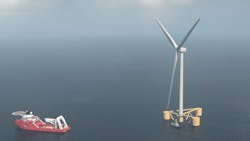Cerulean aims to decarbonize every platform in Scottish waters
Offshore staff
LONDON, UK — Cerulean Winds is making a bid for four "huge gigawatt-scale" sites from Crown Estate Scotland when the auction opens in August, expected to cost about £6 billion each, according to a recent Cerulean news release.
If successful, the company estimates the work would create more than 10,000 UK jobs, the majority in Scotland, with “full fabrication and assembly” of the wind turbine towers and foundations to take place in Britain.
The aim is to help the Scottish supply chain build up scale and expertise now as key ScotWind contracts approach later in the decade.
This comes as Crown Estate Scotland is due to open the Innovation and Targeted Oil and Gas (INTOG) auction next month, a scheme for floating wind projects to deliver green power to offshore platforms.
Engineering firm NOV has been hired as the lead contractor, which has in turn signed a memorandum of understanding (MoU) with the UAE-based fabricator Lamprell on the foundations.
Despite this, Cerulean has pledged that fabrication of the foundations and towers will be in the UK. It added that the expectation is for its partners to be in the UK to build out capacity for heavy fabrication and the levels of work involved would lead to substantial inward investment in the Scottish economy, Cerulean reported.
Funding and costs
At its heart is the ambition for four separate sites – one each to the east and west of Shetland and two in the central North Sea.
Because offshore wind is intermittent, the windfarms need to deliver several times more power than required for the platforms, hence the gigawatt scale.
Excess power will be converted into green hydrogen sent to a processing plant at Shetland—and to one or two others in northern Scotland and east of England—to deliver to local markets.
Each site will be funded via a special purpose vehicle (SPV), owned by Cerulean Winds and institutional investors, covering 30% of the capital needed.
The remaining 70% of funds will be drawn from the infrastructure debt market, where investment banks Societe Generale and Piper Sandler have been engaged.
Cerulean said it has no concerns over meeting the funding targets, with investors sitting "on standby” but money won’t flow until INTOG leases are secured.
Taking this approach means oil and gas firms will be insulated from development costs and will only need to plug and play for the power they use, at a guaranteed price; the company is also in discussions about flexibility in power purchase agreements for platforms for which cessation of production dates are uncertain, and therefore have unclear economics.
Power costs are only one piece of the puzzle, with some operators facing prohibitive costs to modify platforms for electrification.
In these cases, a supply chain consortium partner of Cerulean (undisclosed) will retrofit gas turbines on board platforms to take a blend of hydrogen, helping them meet emissions goals or find a hydrogen solution for heat.
Steel needs
Cerulean is aiming for four sites, each requiring about 1 million tonnes of steel for foundations and the towers, which could cover the lot in terms of offshore platform decarbonization.
However, Cerulean said it recognizes that INTOG is a competitive process, which includes smaller projects too.
Cerulean also has been in talks with firms that are looking at power from shore and how its projects would interact with that infrastructure.
INTOG is seeking to offer option agreements in winter 2023, so the expectation is the projects will be up and running well ahead of ScotWind, giving the supply chain a chance to build up.
If Cerulean does get the INTOG acreage, it will be liable for 4 million tonnes of steel needed for the new floating projects, which the Scottish supply chain cannot deliver alone, Cerulean reported.
Under Cerulean’s plans, some 10,000 UK jobs would be created through fabrication and assembly, with the work to “far surpass” the 50% local content target set out in the North Sea Transition Deal.
Contractors
Cerulean’s objective is to have as many as possible of those contractors having experience of building, fabricating and assembling whole units in the UK, and a request for information has been sent out to the contracting community.
Not everything can be carried out in the UK, hence the non-binding MoU with Lamprell, Cerulean said. In either case, the firm needs more partners to deliver the work and is engaging UK yards.
07.12.2022




